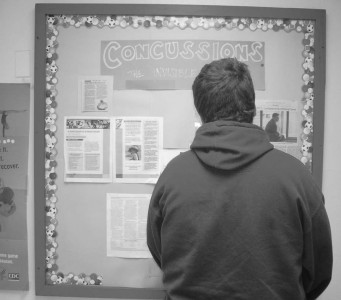Emily Goldberg ’12
Web News Editor

On Oct. 17, college football fans tuned in to the Rutgers versus Army game at the Meadowlands. As they watched Rutger’s defensive lineman, Eric LeGrand deliver a hard-hitting blow to his opponent, viewers waited for him to stand back up, but it never happened. Instead of seeing the 6’ 2,” 260 pound, 20-year-old back on his feet, viewers saw his legs stick out straight, and remain motionless on the ground as a stretcher was brought onto the field.
LeGrand is now paralyzed from the neck down due to the helmet-to-helmet hit he sustained in the Oct. 17 game. This incident as well as other recent concussions and head injuries portrayed in the media, have been a frightening sight to at all, especially those involved in contact sports themselves.
As if LeGrand’s devastating injury was not enough of a scare to all viewers, in the same weekend two NFL players also sustained concussions due to helmet-to-helmet contact hits.
As more of the repercussions of head injuries begin to surface among current and former NFL players, many studies have been conducted citing the long-term effects of these injuries on the brain.
“The media is definitely bringing more attention to concussions and head injuries, and is making society more aware,” Head Athletic Trainer Gaetana “G” Deiso said.
Everyday as athletes walk into Deiso’s office for various treatments, they walk by the bulletin board where Deiso has posted articles and posters on concussions.
One article displayed on the board from the New York Times, entitled “Dark Days Following Hard-Hitting Career in NFL”, talked about the aftermath former NFL player Ted Johnson suffered from continuing to play without taking time off to heal, despite sustaining multiple serious concussions. At 34, he already suffers mild cognitive impairment that is a characteristic of early Alzheimer’s disease.
“I have caught a couple of athletes reading [the articles] and some have even asked questions in regards to some of them,” Deiso said. “Even if it makes one person more aware, we feel like the board has done its job.”
With so much attention focused on concussions in the media, the Staples football team strives to prevent their players from experiencing such serious injuries as recently seen in the college and professional levels.
“We pride ourselves on staying educated on the latest and greatest technology to prevent head injuries,” Head Football Coach Marce Petroccio said.
In addition to having up-to-date and effective helmets and mouth guards, the coaches also teach players strategies to prevent head injuries.
“We do everything in our power to teach proper blocking and tackling techniques so injury is a rare occurrence,” Petroccio said.
All football coaches in Connecticut are also mandated to take courses on concussions in order to be permitted to coach. Petroccio notes that the influx of information coaches and trainers have gained in recent years has made the sport a safer game than it used to be.
“Years ago if you got hit in the head, you’d see stars and just keep on playing. It’s much different now,” Petroccio said. “We’re so much better educated now on both short and long term treatment of head injuries so it is different now than in the past.”
Yet despite their efforts to keep the game as safe as possible, not all head injuries can be prevented. According to Petroccio one member of the team, sustained a concussion at the beginning of the season and is not playing for the remainder of the year as a precautionary measure.
“Anything you do comes with a risk, but to minimize the risk we have our minds set on safety first and winning second,” Petroccio said.













































Mellie • Nov 14, 2011 at 1:36 am
I just hope whoever writes these keeps wrtinig more!